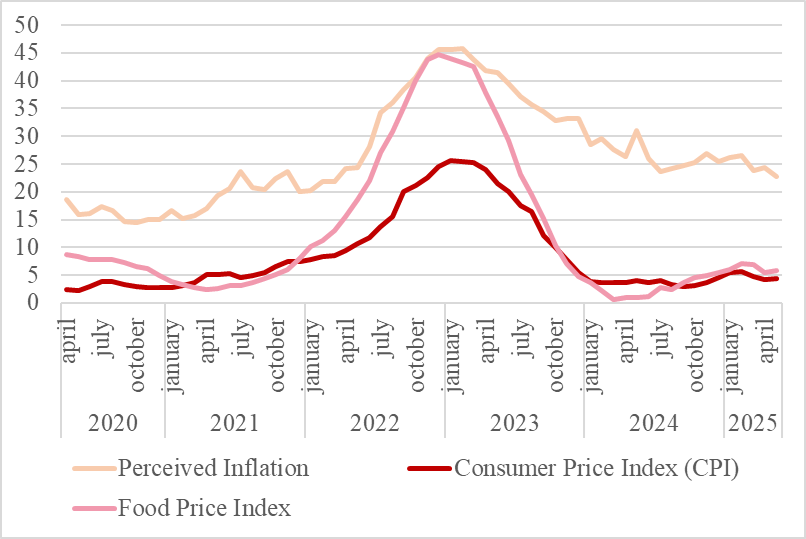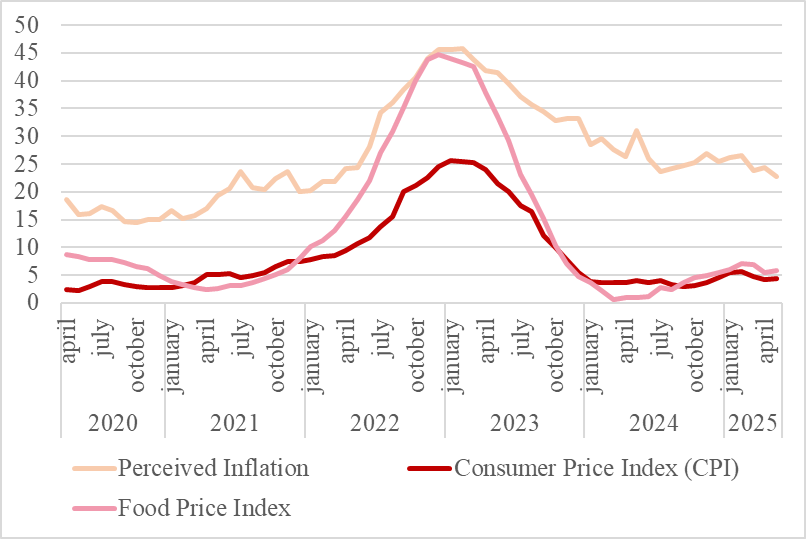
Inflation expectations often function as self-fulfilling prophecies: when households anticipate rising prices, they tend to bring forward their consumption—provided they have disposable income to do so. This leads to increased demand, which in turn drives prices higher.
Perceived Inflation vs. Measured Price Indices in Hungary (2020–2025)

Source: GKI, KSH
These expectations are largely shaped by perceived inflation, which—one might assume—should align with the actual pace of price increases. While consumers do immediately notice price changes, they tend to systematically overestimate their extent. In Hungary, this issue has become more pronounced in recent years: whereas in 2021 consumers perceived the official 5.1% inflation rate as 19.6%, by 2024 the discrepancy widened dramatically, with a measured rate of 3.7% being perceived as 26.6%.
A Global Phenomenon?
This perception gap is not unique to Hungary. Even in the eurozone, home to 350 million people, inflation is consistently overestimated by the public. However, the magnitude of the misperception is significantly smaller: in 2021, the official rate of 2.6% was perceived as 3.8%, and even the largest discrepancy between monthly actual data and expectations never exceeded 8%.
One reason for this lies in long-term stability. A German citizen, for instance, who has used the euro since its introduction in 1999, has never experienced inflation exceeding 4%, which fundamentally shapes their perception of reality. By contrast, Hungarian consumers, having weathered multiple waves of serious inflation, interpret current trends through a more anxious lens. Another factor is the country’s characteristic “Hungarian pessimism”: economic sentiment among Hungarian households tends to be far more negative than in the eurozone.
Perceived Inflation and Consumer Price Index in the Eurozone, 2020–2025

Soruce: European Central Bank
Why Do Hungarians Perceive Inflation to Be So High?
Beyond general pessimism and past economic trauma, several cognitive and structural factors also distort inflation perception. Humans tend to overestimate inflation because negative purchasing experiences linger in memory more strongly than positive ones. Since the average consumer purchases food far more frequently than durable goods or vehicles, changes in food prices weigh heavily on subjective inflation assessments. The spike in food prices in 2022-23 has left its mark on Hungarian consumers: shoppers perceive food as expensive, while prices continue to rise from a high base.
Methodological challenges in inflation measurement further complicate the picture. For instance, Hungary’s Central Statistical Office (KSH) does not include the 50-forint bottle deposit fee in the consumer price index. Further challenges in tracking the prices of fast-technologically evolving consumer durable: how should we measure price changes in smartphones when new models are introduced annually, pushing older models’ prices down? In such cases, consumers often experience rising costs even as official statistics report falling prices.
The highly volatile forint-euro exchange rate has not helped either. According to the Hungarian National Bank (MNB), large currency fluctuations have a negative impact on perceived inflation. Fortunately, the exchange rate has stabilized in recent months.
The performance of the euro area is encouraging: long-term price stability is pushing down perceived inflation, which in turn is reducing price expectations and contributing to a genuinely low rate of price change. However, consistent anti-inflationary fiscal and monetary policies are essential to ensure price stability.







